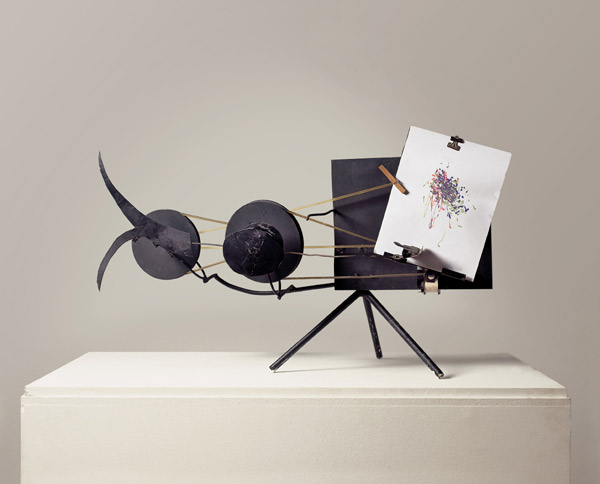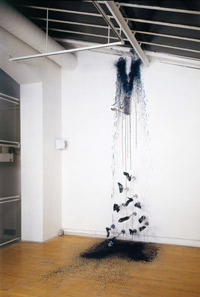We all agree that art is created by artists. But what happens when machines start producing art? Do artists become simple engineers? What can we then consider as the artwork: the machine, the final product or the process of creation? From Jean Tinguely's drawing machines dating back to the 1950s to the ones currently produced by Angela Bulloch, Jon Kessler or Cornelia Sollfrank, all of them have a common feature: they produce their own art. Depending on the mechanical process involved, visitors may keep certain works such as drawings produced by Jean Tinguely's Meta-Matics and certified stamped sheets produced by Damien Hirst's or Olafur Eliasson's machines. To create a machine as an artwork and to entrust it with the responsibility of developing further artworks is a radical step. It means delegating creativity to a piece of equipment. Do such art machines then possess a “soul”?
From Tinguely to the web
The exhibition opens with 20th century works by Jean Tinguely that raise the issue of the machine as an independent creative apparatus in the most original manner. His Méta-Matics that were first exhibited in Paris in 1959 and earned him his international renown are motor-driven drawing machines that enable the spectator to produce abstract drawings. Grouped around it is a selection of works that share a common trait: the creative act is delegated by the artist to the machine - a process that was only possible at the end of the Second World War when a generation of young artists appeared on the scene and broke with one of the best kept taboos of European art: the concept of the original work of art. The selection reflects this process in the most various art media such as painting, drawing, sculpture, video and ends with the greatest “art machine” ever, the World Wide Web, without, however, affording a definitive answer.
Sculptures, drawings ans plastic bottles
The visitor to the exhibition will encounter machines such as Rebecca Horn's Preussische Brautmaschine and Roxy Paine's SCUMAK #2 which produces organic-like sculpture throughout the duration of the exhibition. The drawing machines Making Beautiful Drawings by Damien Hirst and The Endless Study by Olafur Eliasson both require the involvement of the visitor and pose the basic question as to the relationship between onlooker and artwork as well Angela Bulloch's Blue Horizon which needs an external impulse to begin drawing. Jon Kessler's video installation Desert produces sunsets without end, and Tim Lewis' Auto-Dali Prosthetic non-stop scrawls signatures. Pawel Althamer's Extrusion Machine (Bottle Machine) produces blasphemous plastic bottles while Tue Greenfort's Mobile Trinkglaswerkstatt transforms glass bottles into drinking glasses. Finally, with the works of Lia, Miltos Manetas and Cornelia Sollfrank the “Méta art machine” enters into play - the World Wide Web - extending the possibility of democratising art production, as did Tinguely's works in the 1950s.
The artist still present
The relationship between artist, artwork and onlooker is the theme, but not always at the basis of all the exhibits. The art machine enables furthermore the participation of the public and mass-produced art, thus breaking significantly with the aura of non-reproducible art. Even though the onlooker is not directly involved in the creation of some of the works, he/she does gain an insight into its production and is thus led to reflect on the issue as to where the work of art begins. The art machine remains a tool as long as it functions within the parameters of the artist. It is only if and when it starts to act independently and react to situations autonomously that the whole question of authorship can change. The machine may be able to produce without the presence of the artist but it cannot exist without the artist's concept.
PUBLICATION:
Catalogue: Art Machines Machine Art. Ed. Katharina Dohm, Heinz Stahlhut, Max Hollein and Guido Magnaguagno. Preface by Max Hollein and Guido Magnaguagno, Texts by Katharina Dohm and Heinz Stahlhut, and Justin Hoffmann and in-depth comments. German-English edition, c. 160 pages, c. 130 col. & b&w illustrations, hard cover, Kehrer Verlag, Heidelberg, ISBN 9 783939 583400 (Price: CHF 49).
Illlustration: Rebecca Horn (*1944), Die Preussische Brautmaschine, 1988 Prussian blue, bridal shoes, metal construction, brushes, motors: 350 x 120 x 50 cm Collection of the artist © 2008, ProLitteris, Zürich. © Photo: Courtesy Workshop Rebecca Horn (Installation view Seven Obsessions), Whitechapel Art Gallery, London, 1990
| 








